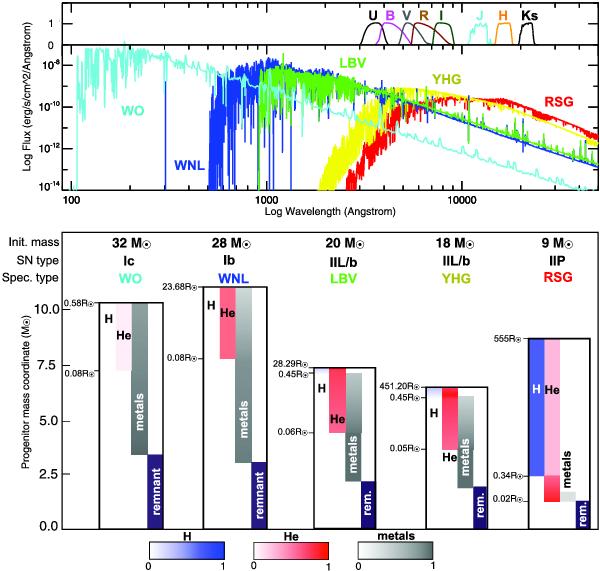Fig. 5

Top: spectral energy distribution of selected models, showing a WO star with Teff ≃ 154 000 K (our 32 M⊙ rotating mode; cyan), a WNL star of spectral type WN10–11 with Teff ≃ 26 800 K (28 M⊙ rotating model; blue), and an LBV with Teff ≃ 20 000 K (20 M⊙ rotating model; green ). We stress that we do not compute model spectra of RSG and YHGs in this paper. To illustrate the SED of these objects, we also overplot MARCS model spectra of a RSG with Teff = 3600 K and luminosity scaled to L⋆ = 1.2 × 105 L⊙ (red), and of a YHG with Teff = 5250 K and luminosity scaled to L⋆ = 1.5 × 105 L⊙ (yellow). All fluxes have been arbitrarily scaled to a distance of 1 kpc. The upper inset shows the normalized bandpasses of the UBVRIJHKS filters. Bottom: schematic illustration of the interior structure of the SN progenitors for which spectra are shown in the upper panel. We show the Lagrangian mass coordinate of the progenitor in the y axis and the extension of the layers for different chemical elements (H, He, metals) and the baryonic remnant mass (computed as in Hirschi et al. 2005). The radius of selected shells is indicated on the left side of each subpanel, while the spectral type, SN type, and initial mass of the progenitors are indicated immediately above the interior structure. The chemical abundances (by mass) are color-coded in blue (H), red (He), and gray (metals).
Current usage metrics show cumulative count of Article Views (full-text article views including HTML views, PDF and ePub downloads, according to the available data) and Abstracts Views on Vision4Press platform.
Data correspond to usage on the plateform after 2015. The current usage metrics is available 48-96 hours after online publication and is updated daily on week days.
Initial download of the metrics may take a while.


